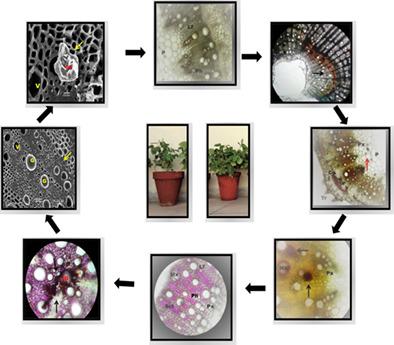当前位置:
X-MOL 学术
›
Microsc. Res. Tech.
›
论文详情
Our official English website, www.x-mol.net, welcomes your
feedback! (Note: you will need to create a separate account there.)
Effect of necrotrophic fungus and PGPR on the comparative histochemistry of Vigna radiata by using multiple microscopic techniques
Microscopy Research and Technique ( IF 2.0 ) Pub Date : 2021-05-24 , DOI: 10.1002/jemt.23836 Sidra Javed 1 , Arshad Javaid 2 , Uzma Hanif 2 , Saraj Bahadur 3 , Shazia Sultana 4 , Muhammad Shuaib 5 , Sajjad Ali 6
Microscopy Research and Technique ( IF 2.0 ) Pub Date : 2021-05-24 , DOI: 10.1002/jemt.23836 Sidra Javed 1 , Arshad Javaid 2 , Uzma Hanif 2 , Saraj Bahadur 3 , Shazia Sultana 4 , Muhammad Shuaib 5 , Sajjad Ali 6
Affiliation

|
Rapid advances in the field of pathogen detection have opened new opportunities and better understanding for their management approaches. Aim of this study was to elucidate histopathological observations of different tissues affected by Macrophomina phaseolina and to observe the defense responses of plant growth promoting rhizobacteria (PGPR) in mungbean plants. Sections of the stem and root were prepared and stained with ferric chloride, Lugol's iodine and Wiesner's reagent and were then observed under multiple microscopic techniques. Results revealed that both pathogen and PGPR produce responses on the plant that include colonization of xylem vessels by hyphae and sclerotia, hypertrophy and hyperplasia of the cells, destruction of xylem fibers and amyloplasts in parenchymatous cells; and production of gels by the plant were observed. There was a significant increase in lignin and phenolic compounds deposition in stem and root sections of PGPR treated and non-treated mungbean plants. Whereas the soil amended with PGPR showed very less to no starch production. Moreover, production of gels and gums were also observed in both stem and root sections. Compared to light microscopy, scanning electron microscope provided greater depth of focus and resolution of the pathogen attack on plant tissues, associated bacteria. As a whole, the data demonstrated that inoculation of PGPR can be an effective strategy to stimulate plant growth and they could significantly activate disease resistance against M. phaseolina.
中文翻译:

使用多种显微技术研究坏死性真菌和 PGPR 对 Vigna radiata 组织化学比较的影响
病原体检测领域的快速发展为其管理方法开辟了新的机会和更好的理解。本研究的目的是阐明受Macrophomina phaseolina影响的不同组织的组织病理学观察结果。并观察植物生长促进根际细菌(PGPR)在绿豆植物中的防御反应。制备茎和根的切片并用氯化铁、Lugol 碘和 Wiesner 试剂染色,然后在多种显微技术下观察。结果表明,病原体和PGPR都会对植物产生反应,包括菌丝和菌核定植木质部血管,细胞肥大和增生,实质细胞中木质部纤维和淀粉体的破坏;并观察到植物产生的凝胶。PGPR 处理和未处理的绿豆植物茎和根部分的木质素和酚类化合物沉积显着增加。而用 PGPR 改良的土壤显示出很少甚至没有淀粉产生。而且,在茎和根部分也观察到凝胶和树胶的产生。与光学显微镜相比,扫描电子显微镜提供了更大的焦点深度和病原体对植物组织和相关细菌的攻击分辨率。总的来说,数据表明接种 PGPR 是一种刺激植物生长的有效策略,它们可以显着激活抗病性。M. 菜豆。
更新日期:2021-05-24
中文翻译:

使用多种显微技术研究坏死性真菌和 PGPR 对 Vigna radiata 组织化学比较的影响
病原体检测领域的快速发展为其管理方法开辟了新的机会和更好的理解。本研究的目的是阐明受Macrophomina phaseolina影响的不同组织的组织病理学观察结果。并观察植物生长促进根际细菌(PGPR)在绿豆植物中的防御反应。制备茎和根的切片并用氯化铁、Lugol 碘和 Wiesner 试剂染色,然后在多种显微技术下观察。结果表明,病原体和PGPR都会对植物产生反应,包括菌丝和菌核定植木质部血管,细胞肥大和增生,实质细胞中木质部纤维和淀粉体的破坏;并观察到植物产生的凝胶。PGPR 处理和未处理的绿豆植物茎和根部分的木质素和酚类化合物沉积显着增加。而用 PGPR 改良的土壤显示出很少甚至没有淀粉产生。而且,在茎和根部分也观察到凝胶和树胶的产生。与光学显微镜相比,扫描电子显微镜提供了更大的焦点深度和病原体对植物组织和相关细菌的攻击分辨率。总的来说,数据表明接种 PGPR 是一种刺激植物生长的有效策略,它们可以显着激活抗病性。M. 菜豆。









































 京公网安备 11010802027423号
京公网安备 11010802027423号